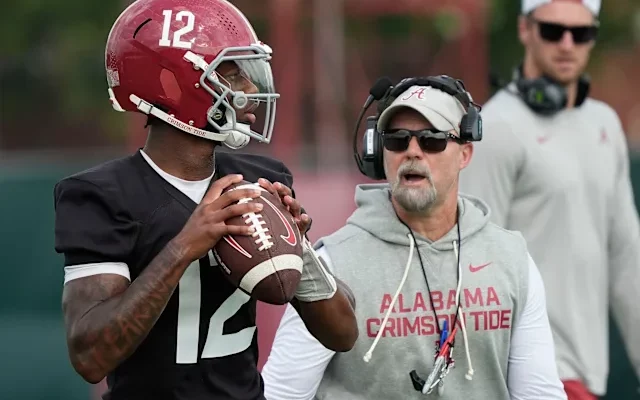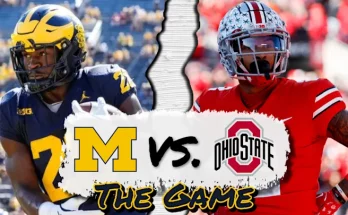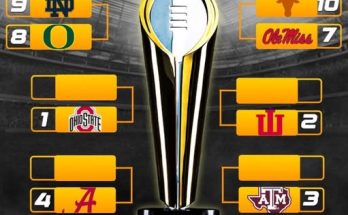Ryan Grubb’s arrival in Tuscaloosa has sent waves of excitement and curiosity throughout the Alabama football program, and rightly so. With a deep pedigree forged in both college and professional football environments, Grubb brings a modernized and sharpened offensive vision that could not only redefine the Crimson Tide’s identity but also usher in a new offensive era at a program that has seen its share of evolution over the last two decades. His NFL experience, though not extensive in terms of years, carries with it tactical and philosophical insights that could impact everything from play design to quarterback development to situational management. As Alabama prepares for a new season under head coach Kalen DeBoer, who brought Grubb with him from Washington, fans, analysts, and players alike are eager to see how this new offensive mind will shape one of college football’s most storied programs.
At the core of Ryan Grubb’s coaching ethos is adaptability. This is something he’s refined through his time coaching at various levels, but the NFL has a way of distilling those concepts even further. In the professional game, time is short, margins are thin, and complexity reigns. Grubb was part of the San Francisco 49ers’ coaching system during an offseason internship and has long been a student of NFL trends. His offensive schemes reflect a growing marriage between college creativity and pro-level precision. At Washington, he implemented a passing attack that was surgical, timing-based, and incredibly effective, helping quarterback Michael Penix Jr. elevate his game to new heights. Now at Alabama, Grubb inherits a different type of challenge. Alabama is not starting from scratch, but rather recalibrating after an era where the offense oscillated between run-heavy physicality and high-flying spread concepts. Grubb’s task will be to meld Alabama’s traditional strengths with the sophistication and flexibility demanded by modern football, something he is uniquely equipped to do thanks to his exposure to NFL concepts.
One of the clearest ways Grubb’s NFL experience could change Alabama’s offense is through his approach to quarterback development. The NFL places a premium on quarterbacks who can process information quickly, make precise throws under pressure, and read multiple levels of the field. These traits are not just encouraged at the next level; they’re expected. At Alabama, Grubb will be tasked with unlocking the full potential of whoever wins the quarterback job—whether that’s Ty Simpson, Dylan Lonergan, or another rising talent. In the past, Alabama quarterbacks under coaches like Lane Kiffin, Steve Sarkisian, and Bill O’Brien have flourished by mastering structured systems that emphasized timing and progression reads. Grubb’s experience could take that a step further. His use of layered route combinations, deep play-action elements, and timing-based throws will likely demand more from Tide quarterbacks in terms of pre-snap recognition and post-snap processing, closely mirroring what NFL signal-callers face every Sunday. This approach will not only help Alabama win games but will also make the quarterback room more NFL-ready—a massive recruiting pitch for top-tier QB prospects.
Beyond quarterback play, Grubb’s NFL-influenced philosophy will likely manifest in the way Alabama structures its offensive formations and sequences its plays. NFL offenses rely heavily on formational diversity, motion, and deception to create mismatches and exploit defensive tendencies. Expect Alabama to move more toward condensed formations, pre-snap motion to diagnose coverages, and bunch sets that create leverage advantages—all staples in professional offenses. These tools were visible in Washington’s offense under Grubb, and when used correctly, they make defenses play slower because of the mental processing required before the snap. For an Alabama team that has struggled at times to get its best athletes in open space, Grubb’s command of spacing and leverage could be a game-changer. By spreading the field horizontally with motion and varying alignments, then attacking vertically with aggressive route concepts, Alabama’s offense could become much more dynamic and less predictable.
Grubb’s NFL sensibilities are also likely to impact how Alabama handles third downs and red zone opportunities. These two areas are notoriously difficult in college football, and many teams struggle to consistently convert because of poor play sequencing or a lack of schematic variety. In the NFL, where defenses are smarter and windows are tighter, play-callers have to be extremely intentional with their scripts. Grubb brings that mindset. He’s known for sequencing plays in a way that sets up future calls—what’s known in coaching circles as “playing chess, not checkers.” For example, he might call a zone run three times in a row to draw the linebackers in, only to burn them with a tight end seam route off play action. These kinds of strategic layers require discipline, repetition, and trust, but they can elevate an offense to elite levels. At Alabama, where the talent is unmatched, the right sequencing can turn good plays into great ones and decent drives into scoring drives. This is especially crucial in the red zone, where field constriction and defensive pressure can turn high-powered offenses into conservative units. Grubb’s ability to scheme receivers open through tight spacing and design deceptive run-pass options will be vital to Alabama’s scoring efficiency.
Another key influence from the NFL that Grubb is likely to bring to Alabama is situational awareness. The pro game thrives on situational mastery—two-minute drills, end-of-half strategies, third-and-short, and four-minute offense. These are the hidden battles within the game that separate elite teams from average ones. Alabama has long been a team that excels in these areas under Nick Saban, but with Saban now retired, maintaining that edge becomes even more important. Grubb’s understanding of situational football, honed by studying NFL tendencies, should help Alabama stay sharp in critical moments. This includes play design for fourth downs, creating packages specifically for short-yardage scenarios, and using clock management as a weapon rather than a reactionary tool. These details often go unnoticed by casual fans, but they win championships.
Recruiting is another area where Grubb’s NFL-style offense will have a ripple effect. Top-tier high school receivers, running backs, and offensive linemen all want to play in systems that not only highlight their talents but also prepare them for the next level. Grubb’s offense can do both. His system gives wide receivers clear route definitions, allows them to line up in multiple spots, and teaches them how to read coverages on the fly—skills that NFL scouts love to see. Running backs in Grubb’s system won’t just be asked to pound the rock; they’ll be integrated into the passing game with wheel routes, angle routes, and pass protection assignments that mimic what they’d be asked to do in the league. For offensive linemen, the variety in blocking schemes—from zone to gap to pass-protection slides—gives them a more complete toolkit for when they make the jump to Sundays. This comprehensive developmental plan makes Alabama not just a winning program but a true pipeline to the NFL.
Then there’s the matter of tempo. Grubb has shown flexibility in how he controls the pace of a game. At Washington, he could slow it down to preserve leads or go no-huddle to put pressure on opposing defenses. That kind of control over tempo is a hallmark of NFL-level thinking, and it allows a team to dictate terms rather than react. Alabama has traditionally been a team that could impose its will on opponents physically. Grubb’s offense gives them the chance to impose their will mentally. This mental strain—constant shifts, motion, tempo changes—can wear down even the most disciplined defenses over four quarters.



